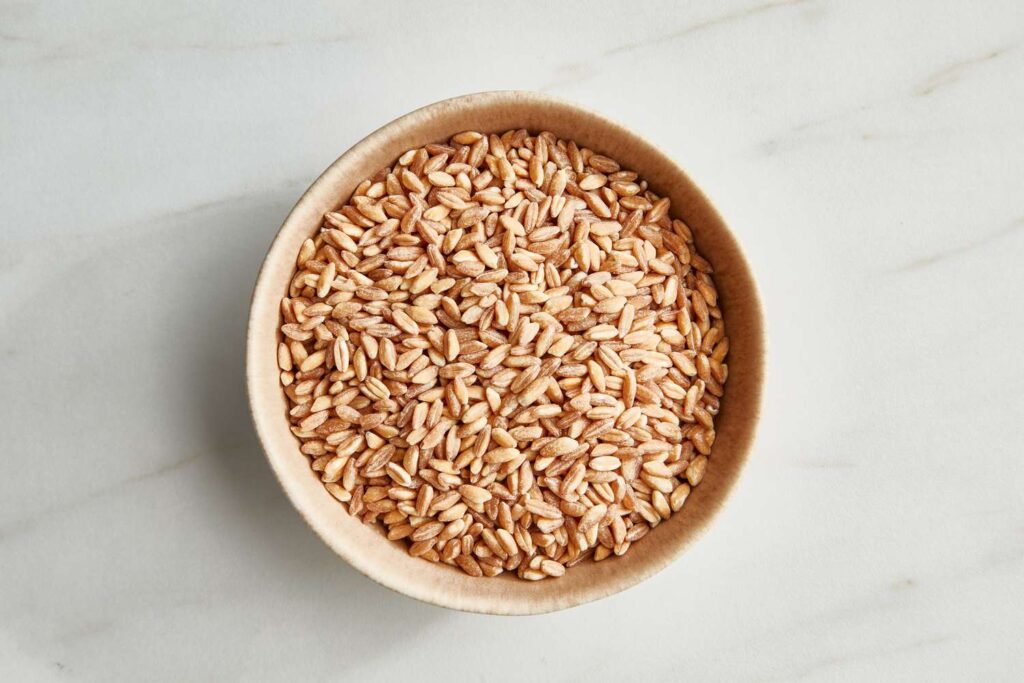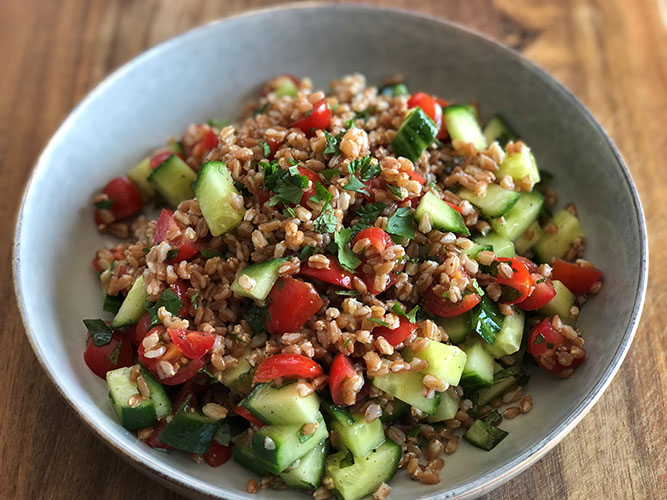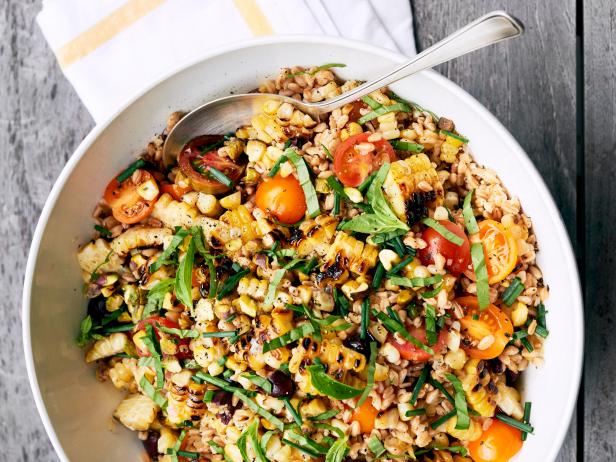
How to Cook Farro – Easy and Delicious Recipes
Farro is an ancient grain that has been cultivated for thousands of years and is commonly used in Mediterranean and Middle Eastern cuisines. It is a type of hulled wheat, meaning that its outer husk is removed but the bran and germ remain intact, providing a chewy texture and nutty flavor. Farro is often used in soups, salads, and as a side dish, and it is known for its nutritional benefits.
Types of Farro
There are three main types of farro, each with varying degrees of processing:
Whole Farro: This is the least processed form and retains all of its bran and germ. It has the most nutrients but requires the longest cooking time and often needs to be soaked overnight.
Semi-Pearled Farro: Some of the bran is removed, which reduces cooking time but still retains much of the grain’s nutritional value.
Pearled Farro: Most of the bran is removed, resulting in a shorter cooking time and a slightly less chewy texture. This type is the quickest to prepare but has fewer nutrients compared to whole or semi-pearled farro.
Nutritional Benefits
Farro is a nutritious grain that offers several health benefits:
High in Fiber: Helps with digestion and maintaining a healthy weight.
Rich in Protein: Contains more protein than many other grains, making it a good option for vegetarians and vegans.
Contains Vitamins and Minerals: Provides magnesium, zinc, iron, and B vitamins.
Antioxidants: Contains antioxidants that help protect cells from damage.
Ingredients:
1 cup of farro (whole, semi-pearled, or pearled)
3 cups of water or broth (adjust the liquid ratio based on the type of farro)
1 teaspoon salt (optional, for seasoning)
Optional: herbs, garlic, bay leaf, or other flavorings

Cooking Instructions:
1. Preparation:
Rinse the Farro: Place the farro in a fine-mesh strainer and rinse under cold water to remove any dust or debris.
Soak (for Whole Farro): If using whole farro, it’s recommended to soak it in water overnight. This helps reduce cooking time and ensures even cooking. Drain before cooking.
2. Cooking: Whole Farro
Combine Ingredients: In a medium saucepan, combine 1 cup of soaked whole farro with 3 cups of water or broth.
Boil and Simmer: Bring to a boil over medium-high heat, then reduce the heat to low, cover, and simmer for about 30-40 minutes, or until the farro is tender but still chewy.
Drain Excess Liquid: If there’s any excess liquid, drain it off. Fluff the farro with a fork.
Semi-Pearled Farro:
Combine Ingredients: In a medium saucepan, combine 1 cup of semi-pearled farro with 3 cups of water or broth.
Boil and Simmer: Bring to a boil over medium-high heat, then reduce the heat to low, cover, and simmer for about 20-30 minutes, or until the farro is tender but still chewy.
Drain Excess Liquid: If needed, drain off any excess liquid. Fluff with a fork.
Pearled Farro:
Combine Ingredients: In a medium saucepan, combine 1 cup of pearled farro with 2 cups of water or broth.
Boil and Simmer: Bring to a boil over medium-high heat, then reduce the heat to low, cover, and simmer for about 15-20 minutes, or until the farro is tender but still chewy.
Drain Excess Liquid: Drain off any excess liquid. Fluff with a fork.
Flavoring Options:
Herbs and Spices: Add bay leaf, thyme, rosemary, or garlic to the cooking liquid for extra flavor.
Broth Instead of Water: Use vegetable, chicken, or beef broth instead of water to enhance the taste.
Salt: Add 1 teaspoon of salt to the cooking liquid if desired.
Serving Suggestions:
Salads: Mix cooked farro with fresh vegetables, herbs, olive oil, lemon juice, and feta cheese for a hearty salad.
Side Dish: Serve as a side dish seasoned with olive oil, salt, pepper, and fresh herbs.
Soups and Stews: Add cooked farro to soups and stews for added texture and nutrition.
Breakfast: Use cooked farro as a base for a warm breakfast bowl, topped with fruits, nuts, honey, and a splash of milk or yogurt.

Tips:
Texture Check: Farro should be tender but still have a slight chewiness. Taste a few grains toward the end of cooking to check for doneness.
Storage: You can store cooked farro in an airtight container in the refrigerator for up to 5 days. Reheat by adding a little water or broth to restore moisture.
FAQ:
What is farro?
Farro is an ancient grain that belongs to the wheat family. Farro is high in fiber, protein, and various nutrients, making it a nutritious addition to meals.
What are the different types of farro?
There are three main types of farro: whole farro, semi-pearled farro, and pearled farro. Whole farro retains all of its bran and germ, requiring the longest cooking time. Semi-pearled farro has some of the bran removed, which reduces cooking time. Pearled farro has most of the bran removed and cooks the fastest.
How much liquid do I need to cook farro?
The general liquid-to-farro ratio is:
Whole farro: 3 cups of water or broth to 1 cup of farro.
Semi-pearled farro: 3 cups of water or broth to 1 cup of farro.
Pearled farro: 2 cups of water or broth to 1 cup of farro.
How long does it take to cook farro?
Cooking times vary based on the type of farro:
Whole farro: 30-40 minutes (after soaking).
Semi-pearled farro: 20-30 minutes.
Pearled farro: 15-20 minutes.
Should I season the cooking water?
It’s a good idea to add a teaspoon of salt to the cooking liquid for flavor. You can also add other seasonings such as bay leaves, garlic, or herbs.
How do I store cooked farro?
Store cooked farro in an airtight container in the refrigerator for up to 5 days. You can reheat it by adding a little water or broth to restore moisture.
Is farro gluten-free?
No, farro is a type of wheat and contains gluten. It is not suitable for those with celiac disease or gluten intolerance.
Can I freeze cooked farro?
Yes, cooked farro can be frozen. Let it cool completely, then store in a freezer-safe container or bag for up to 3 months. Thaw in the refrigerator and reheat as needed.
What are some flavoring options for farro?
Flavor farro by cooking it with broth, adding herbs like thyme or rosemary, garlic, bay leaves, or spices like cumin and paprika. After cooking, you can toss it with olive oil, lemon juice, or vinaigrette for added taste.